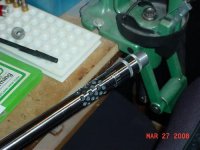P
pacecil
Guest
The question of whether threading the muzzle will distort the bore is again one of those things that can easily be determined by calculation. (I know! this is "book stuff" and many shooters just don't believe it.) For example if the bore should be stressed as high as 60000 psi in compression (which would probably be very high.) and you machined enough material off the O. D. to drop the bore stress down to 30000 psi, you would cause the bore to increase by .00026. This would occur only right at the crown. Back where the threads end along the barrel the increase would be less, down to almost zero. This means the barrel becomes blunderbuss shaped. All agree this affects accuracy.
All this depends on size of the barrel, who much you machine from the barrel, and how high the compressive stresses are in the bore. Any way, you can put your own numbers in and with a little calculation come up with whether or not you think machining the O. D. will hurt. This is not rocket science!
All this depends on size of the barrel, who much you machine from the barrel, and how high the compressive stresses are in the bore. Any way, you can put your own numbers in and with a little calculation come up with whether or not you think machining the O. D. will hurt. This is not rocket science!



